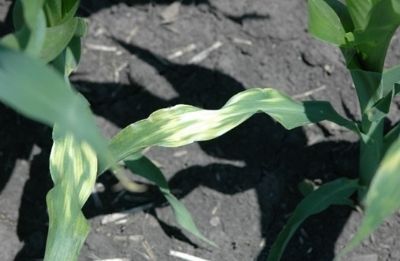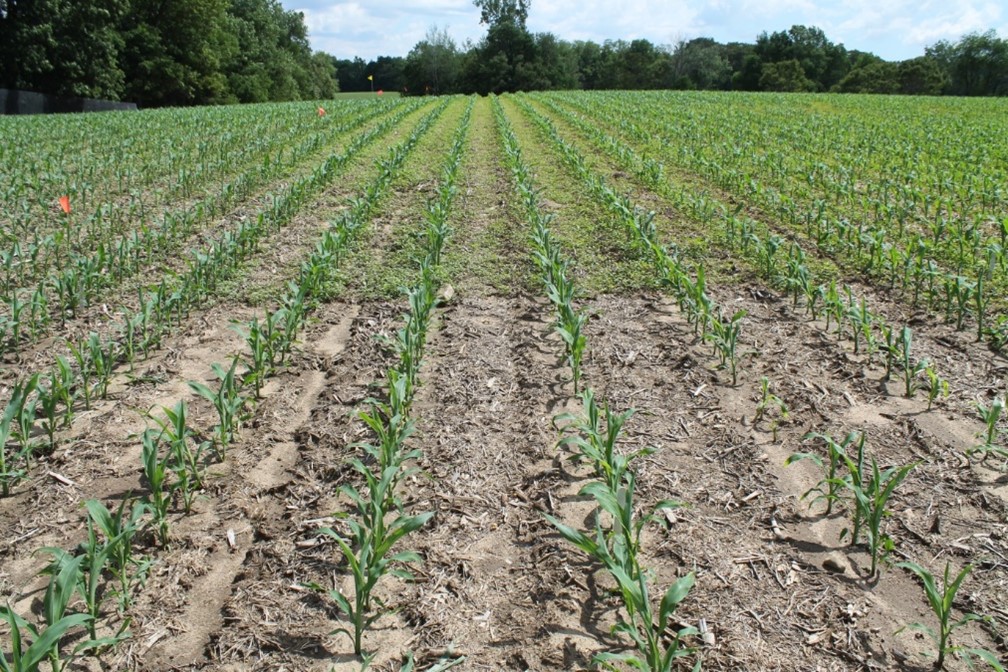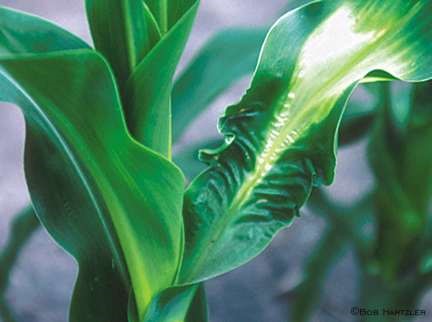 Image 2: HPPD herbicide + OP insecticide injury on corn. (source: Dr. Aaron Hager; University of Illinois)
Image 2: HPPD herbicide + OP insecticide injury on corn. (source: Dr. Aaron Hager; University of Illinois)
- To optimize the length of residual weed control, preemergence residuals should be applied as close to planting as possible.
- Preemergence residual weed control is particularly important for problematic weeds such as waterhemp and giant ragweed, to name a few.
- Residual herbicides should include multiple effective sites of action on the targeted problem weed(s) at recommended label rates.
- Organophosphate (OP) insecticides tank mixed with certain herbicides can be injurious to crops.
The continued development of multiple herbicide resistant weeds has made weed management more challenging. Waterhemp, one of the most common tough to control weeds, has developed resistance to some of the more common sites of action available. For example, most waterhemp is resistant to, ALS (i.e. Pursuit®), EPSPS (i.e glyphosate) and PPO (i.e. Cobra®) inhibiting herbicides. There is a lot of emphasis on waterhemp control, and rightfully so, but we are starting to see some resurgence of more competitive weed species such as common cocklebur, giant ragweed, and velvetleaf. Weed escapes over the past few years have increased the amount of weed seed that is contributing to the weed seed bank.
Herbicide programs are most successful when they maximize their residual potential and when they include multiple effective sites of action on the targeted weed(s). Maximizing the residual potential simply means that you want to avoid applying your preemergence residual too far ahead of your planting date. A preemergence residual provides the greatest return on investment when applied right before planting, or within three days after planting the crop. Remember that when soil temperatures are above 50°F, most herbicides are prone to microbial degradation, resulting in less active ingredient in solution for residual weed control. To mitigate some of the pressure on the POST herbicide and to best utilize the full length of the residual, it is critical to apply that preemergence residual at planting, or as close to planting as possible.
Using multiple effective sites of action is recommended for best management practices (BMP’s) for weed resistance management, and to help broaden the spectrum of control. Multiple effective sites of action help to delay the onset and spread of herbicide resistance. For example, applying a preemergent tank mix containing a PPO inhibitor, a Photosystem II inhibitor, and an ALS inhibitor will provide two effective sites of action on small seeded broadleaf weeds and one site of action on large seeded broadleaf weeds like giant ragweed. Ensuring that you have multiple effective sites of action in the tank will help alleviate some of the pressure on the POST herbicides. Let the PRE herbicides “thin the heard” so the postemergence application doesn’t have to work as hard (Image 1).

Image 1: Value of a preemergence residual followed by early postemergence application (front) over just a single postemergence pass (back).
Corn preemergence residuals are typically easier to predict. Most times the tank mix will include atrazine with either an HPPD inhibitor or a Long Chain Fatty Acid (LCFA) inhibitor, and sometimes both. Atrazine is effective on a large range of weed species, including waterhemp and large-seeded broadleaf weeds, while the HPPD and LCFA inhibitors are also very effective on waterhemp, typically our most problematic weed.
Be aware that the use of certain organophosphate (OP) insecticides for below ground insect control mixed with certain preemergence herbicides such as ALS, HPPD or PPO inhibitors, can result in crop injury. This is due to OP insecticides and certain herbicides utilizing the same metabolic detoxification pathway, resulting in a toxic buildup of these products within plant tissues. With some combinations, the injury can be detrimental to grain yield, while other combinations may result in only a temporary superficial injury (Images 2 & 3). Pyrethroid insecticides may provide a safer alternative to OP’s when ALS, HPPD or PPO herbicides are used. Remember to always read and follow the label and make sure you cross-check compatibility of your herbicide program against any at-plant soil applied insecticides. This also applies to any post-emergent insecticide applications that are planned or made in response to a pest outbreak, as there is usually a wait period to when it is safe to use certain OP insecticides following a preemergence herbicide application.

Image 3: above ALS herbicide + OP insecticide injury to small corn. (source: Iowa State University Extension)
As the spring season approaches it is important to keep in mind that successful weed management requires several BMP’s. One of those BMP’s is the use of a preemergence residual with multiple effective sites of action on the targeted problem weed species. It is also imperative to apply that preemergence residual as close to planting as possible at labeled rates, to gain greater weed control for a longer period in crop. Without the use of preemergence residuals, weed control will most likely be poor or ineffective. For more information on weed resistance management contact your local FS Crop Specialist.